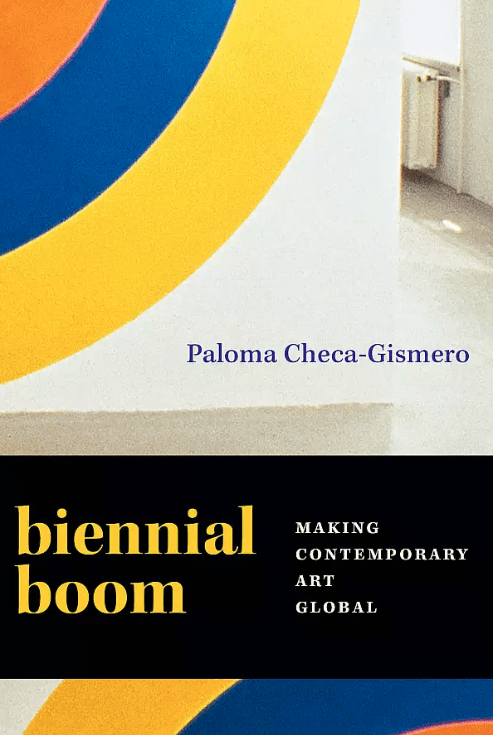It is commonplace that art biennials have played a pivotal role in the configuration of contemporary cultural production and display. These recurrent, large-scale events are responsible for the ways in which global contemporary art operates and is discussed. Our “art world” is very much the result of the specific configuration that the biennial form tested, perfected and expanded around the turn of the century–or, at least, for canonical understandings of such configuration. That biennials were crucial in the articulation of what has come to be called global contemporary art is a well-known, oft repeated story. In fact, criticism engaging with biennials is often accused of the same repetitiveness of biennials themselves: it is, thus, associated with a sense of repetitiveness, a high level of conformism, and a lack of alternatives.
Paloma Checa-Gismero’s Biennial Boom: Making Contemporary Art Global offers a salutary and welcome exception to this. In this book, Chega-Gismero advances a nuanced, detailed, far-reaching, and ultimately merciless analysis of art biennials. Drawing on close engagement with three key examples that helped finetune the biennial form—the Havana Biennial, inSITE and Manifesta–, Chega-Gismero argues for a renewed understanding of the role of biennials as crucial agents of and platforms for political stabilization and economic neoliberalization.
Biennial Boom demonstrates that the proliferation of biennials is constitutive of the political atmosphere of the 1990s. In effect, the book proves that biennials exceled at capturing the aspirations and anxieties of post-Cold War societies. The emphasis on global circulation and conviviality prefigured late 20th century free trade and globalizing ideologies; the coexistence of artists and artworks from multiple continents created the perfect ground for an aesthetics of conflict resolution; the strategic engagement with local histories generated that an appetite for cultural exchange and the consumption of experience that fitted 1990s elite communities seeking to transcend parochialism and display their cosmopolitan fluency like a glove.
None of this is new, of course, but Paloma Checa-Gismero brings the most satisfactory and nuanced interpretation of causes and consequences, agents and interests, related to the biennial phenomenon to date. Central to the book’s argument is the idea of biennial conversions, defined as the “discursive and material efforts to accommodate and value difference, while simultaneously prefiguring a pacified world through the cyclical temporality of globally oriented art exhibitions.” (6) Conversions therefore played a role that exceeded that of arbitrating between artistic trends and cultural scenes: through conversion, difference became globally accessible and palatable. This project, Checa-Gismero argues, is far from neutral. On the contrary, it is founded on “concessions, cuts, exclusions, and alterations of the cultural objects and genealogies that had previously been excluded from dominant North Atlantic art worlds.” (6)
The consequences of adopting a critical perspective based on biennial conversions are many. First, what is normally addressed as a history of increasing globalization based on an interest in difference becomes shifts into a somehow more provincial, more situated account. One of the key virtues of Biennial Boom is in interest in class analysis: Checa-Gismero demonstrates the parochialism of global gestures produced by local elites. She also puts the finger on the processes of precarization of most artists joining the biennial circuit. These, the author argues, provided the perfect example of transnational workers under neoliberal conditions. Artists were “converted” into global agents at the expense of their own social and economic stability, paving the way for similar conversions in practically all areas of production.
A second element that derives from the main concept advanced in Biennial Boom is critical exhaustivity. Moving away from wore out debates on sameness and difference within biennial curatorial practice, Checa-Gismero centers attention on how multiple agents benefited, and suffered from the engagement with biennial conversions. Scholarship on the “biennial boom” tends to gather examples and offer a panoramic, comparative view. This is not the case with Biennial Boom. What we find, instead, is an attentive account of how three locations—Havana, Santa Fe/Tijuana and Rotterdam—helped defining and normalizing “global contemporary art.” This approach allows Checa-Gismero to remain attentive to the multiplicity of agents involved in all three scenarios without conflating their roles within single-voiced narrations. Thus, throughout the book the reader will discover how Mexican artists took advantage of San Diego’s anxieties for becoming a major contemporary art center that could rival with key Californian locations such as San Francisco or Los Angeles. How the interest in branding “European Art” in Manifesta generated frictions with Eastern European artists and curators; and how the definition of a non-aligned, “third-world aesthetic” in Havana evolved side by side Cuban’s geopolitical rearticulation after the fall of the Soviet Union. Checa-Gismero achieves to portray these stories as central nodes of global contemporary art configurations. What emerges here is a nuanced and carefully crafted narrative, one that shifts the attention from the bigger picture into the myriad details and smaller decisions that would end up configuring a biennial global landscape.
Finally, the centrality of conversions within Biennial Boom has the positive effect of apprehending subversive and conservative interventions within the same frame. In this sense, Checa-Gismero defends that “the class affiliations of influential actors within the early-boom biennials often have the effect of watering down and sometimes erasing the inclusionary intentions and liberatory drives behind the dialogical aesthetic framework.” This, in turn, produced and exacerbated already existing “social divisions and relations of coloniality.” (13) With the impatience for political correctness and disciplinary conventions that characterizes the book, Checa-Gismero examines the understudied story of how biennials allowed for neocolonial gestures and cultural appropriation practices. These were often hidden behind an appearance of conviviality, which made emphasis on conflict resolution in ways that resemble and anticipate Fukuyama’s end of history thesis. Ultimately, biennial conversions transformed an ideology of peacefulness and encounter into a tool for neoliberalization. Of course, this is not the entire story, but it remains nonetheless a central part of any story to be told about biennials and global contemporary art. Indeed.
What brings together the three case studies of Biennial Boom—the Havana Biennial, inSITE and Manifesta—is their emergence in what Checa-Gismero describes as the peripheries of the North Atlantic world. Central to the arguments offered in the book is the idea that biennials facilitated the expansion of Western European and US elite art worlds (7) by incorporating and translating artistic genealogies that were less known or had been excluded during the Cold War period. Through biennial conversions, “cultural forms practiced outside of elite North Atlantic art worlds [were turned] into codes that would be legible to the new global art publics.” (9) This logic, however, works differently in each of the three main cases examined in Biennial Boom. Havana is presented as a resistive, anticolonial project that managed to offer an alternative to this mainstream model; InSITE is portrayed as more closely aligned with the elites living in San Diego and Tijuana and operating across the US/Mexican border in the context of the NAFTA Agreement; and Manifesta (especially its first edition) would operate under the logic that Western European liberal democracies provided the model to be followed by any other political and cultural actor.
The emphasis on the North Atlantic has the virtue of bringing the examination of the three chosen case studies closer. At the same time, it begs the question of which role was played by platforms such as Dak’art, Johannesburg, Gwangju that shaped global contemporary art in crucial ways and engaged with biennial conversions in its own terms, without caring too much about the North Atlantic axis defined by Checa-Gismero. This, of course, does not make them necessarily “better biennials”, nor does it position these examples as more suited for responding to the aims and objectives Biennial Boom is organized around. Rather, the issue here is one of perspective and framing: by highlighting the North Atlantic art world, even if such highlighting entails a criticism of neocolonial gestures and neoliberal processes, a particular geography emerges, one that maintains the axis of canonical interpretations of modern art intact. To be sure, Checa-Gismero does a huge job in coming to terms with the contradictions of such North Atlantic model. The author also purposefully moves away from its centers to settle in the peripheries, a movement that allows her to examine the expansion and the fractures of the model. At the same time, however, it could be asked what kind of genealogies of biennial conversions and biennial boom might emerge when Northern American and Western European audiences and interests are displaced out of the center (a displacement, to be sure, that does not imply ignoring cultural appropriation and provincialism).
This question notwithstanding, Biennial Boom manages to provide a coherent and nuanced picture of a crucial moment in art history, that of the last decades of the 20th century. The book is divided into three sections, each of which includes three chapters. The first section is dedicated to the origins of the Havana Biennial. Here, Checa-Gismero redefines the history of this key art event by underscoring the original curatorial and collaborative creative strategies mobilized by the biennial team in order to provide an alternative to canonical exhibitionpractices. In Chapter one, Checa-Gismero situates the biennial within the political debates on socialism taking place in Cuba and Latin America, and more specifically within the interest to move away from determinist understandings of Marxism. This does not impede the author to recognize that “since its beginning, the Bienal occupied a delicate position. While it acted as a counter-hegemonic aesthetic operation abroad, internally, the exhibition helped strengthen elites’ grasp on the local contemporary art scene.” (35) Of particular interest in this chapter is the detailed engagement with the Bienal’s curatorial team, which displayed research strategies based on the Marxist tradition of foquismo. Based on Ernesto Guevara’s revolutionary theory, foquismo relied on the possibility of finding allies that could create small focal points that later on would expand and converge with sympathetic trends. From this perspective, Checa-Gismero argues that “the Bienal institutionalized Left-leaning liberal tendencies within Cuban socialism at the time, foregrounding the importance of culture as a space for the enactment of emancipated social relations.” (52)
Collaboration was key to materialize this model. Chapter two expands on the synergies created between the Bienal’s curatorial team and the strategies adopted to compensate for the lack of resources and the specificities of the Cuban cultural and political context. These collaborative strategies will produce a model that would later on be exported and adopted in multiple biennials around the globe. Here, Checa-Gismero offers a less-known, close up image of the negotiations and strategies at play in the organization of the first editions of the Havana Biennial, achieving in this way to ground and nuance the examination of biennial conversions advanced in the book’s introduction.
Finally, Chapter three analyzes how production was favored in detriment of spectacular display and consumption, prefiguring “the possibility of an anticolonial art world [and pursuing] alternative models of aesthetic value.” (73) Of special interest is the discussion of the role that crafts and collaborative creativity happening outside the art world played in the ideological and cultural definition of the Bienal. Biennial Boom reaches one of its most original points by describing in detail how the work of craft makers from Cuba and Latin America advanced a subversive and unique approach to Socialist aesthetics, one resonant with Marxist understandings of labor and value yet also capable of maintaining Latin American anticolonial experiences at its center.
Out of the three examples examined in Biennial Boom, Havana clearly stands out as the one the author feels more sympathetic for. This first block advances important insights into the negotiations and strategies taking place in the crucial temporal horizon discussed in the book. At the same time, it opens up ground for further questioning: could the articulation of parallel events during biennial time, so common in the case of Havana, be interpreted by following the same premises that are applied to the main event? How were individual artists negotiating their positioning within the framework of a Third World avant-garde? Speaking of which, in which ways did the biennial come to terms with the fact that its organization in 1984 also marks the end of formal decolonization in non-Western territories? Could we see a biennial conversion of a different kind operating here in the ways in which the Bienal mobilized anticolonial aesthetics? Was there a negotiation, a curating, of anticolonial genealogies of collaboration and production? Biennial Boom hints at some of these questions but also leaves space for further analysis.
The book’s second block is dedicated to inSITE, the site-specific biennial event taking place between San Diego and Tijuana. In Chapter four, Checa-Gismero problematizes the understanding of globality at play in this iconic recurrent exhibition of site-specific artistic projects. The author reveals how the “hopes for convergence and collaboration informed the mission of inSITE.” (100) At the same time, Checa-Gismero argues that such hopes were curtailed by the interests of local elites seeking to use the art system’s appetite for mobility and frictionless convergence that the border in the post-NAFTA period could evoke to their own advantage. This aspiration generated a disparity between local artistic communities knowledgeable of the living conditions of border communities, and transnational artists who approached “border life” as a topic. In Checa-Gismero’s words, the latter tended to produce work that “relied on artistic languages developed under interpretive regimes that favor art’s formalism over its practiced engagement with social life.” (103)
One of the more ironic, and funniest, parts of Biennial Boom is Chapter five, where the “fears of provincialism” of local elites is discussed and the artistic responses seeking to mock and evince that fear are explored. Checa-Gismero draws on Yúdice’s and García Canclini’s interpretation of inSITE as a cultural maquiladora, a factory that would render the border palatable as a site for culture instead than as a policed zone of conflict and marginalization. InSITE, Checa-Gismero argues, reveals how “the desire of borderlands elites to overcome long-held feelings of provincialism channeled their support of global contemporary art through an art biennial during this period of neoliberal expansion.” (127). inSITE emerges here as a crucial agent of neoliberalization and “creative boosterism” (134), one that justifies its relevance by alluding at the potential of contemporary art for flattening difference and foreclosing conflict. In response to this approach, Biennial Boom engages with work by artists such as Andrea Fraser or David Jurist, who were critical of inSITE’s aesthetic formalism. Ultimately, Checa-Gismero shows how an emphasis on collaboration can be curated to fuel ideological positionings based on market expansion and “aspirational cosmopolitanism.” (138)
Part of the critical purchase of inSITE had to do with underscoring the richness of Mexican art for Northern American audiences. Chapter six engages with the negotiations and strategies that Mexican artists put into practice in order to participate in, and take advantage of, this key venue of the biennial circuit. Thus, Checa-Gismero explores how an emergent artistic community from Mexico City turned the biennial into an opportunity to join global contemporary art arenas. As is the case throughout the book, Checa-Gismero avoids generalizations and manages to portray all agents involved into this equation in their own light.
Biennial Boom concludes with a third and final section on the first iteration of the European biennial Manifesta, which took place in Rotterdam in 1996. Chapter seven sets the tone of the section, introducing the reader to the intricacies of this unique biennial that sought to generate a new category, that of “European art”, which was in turn seen as a strategic asset for the consolidation of a united European framework in the context of what would become the European Union. The key idea is that exhibitions such as Manifesta “recruited contemporary art to support the daunting task of joining the culturally, ethnically, and politically diverse people living in the territory called Europe under a new felt sense of belonging to the territory and people informing what would be the EU.” (174) This task was not without controversy, as Chapter eight demonstrates. Here, we follow the steps of Eastern European artists who had to negotiate their position vis-à-vis a grand curatorial design based on the absence of conflict. This chapter therefore does two things: it engages with the curatorial ethos of the first edition of Manifesta and also assesses the impact of the critical responses to that ethos. Finally, Biennial Boom’s last chapter reveals that the community of local artists working in Rotterdam played a crucial role that ended up changing the biennial’s script and generating a cooperative model for subsequent biennials.
Biennial Boom is unique in its straightforwardness, in its allergy to political correctness, in its emphasis on issues of class and socioeconomic inequality within biennial practice. As any book of this kind, one gets the feeling that there could be more to explore, more questions to be answered. Checa-Gismero’s first monograph acknowledges these options and ends up with an open and generative conclusion, one that paves the way for further work in this productive line.
Carlos Garrido Castellano is Senior Lecturer/Associate Professor in University College Cork, where he coordinates a BA programme on Portuguese Studies. He is also Senior Associate Researcher at the Visual Identities in Art and Design (VIAD), University of Johannesburg. He is Principal Investigator of the IRC Laureate Consolidator Project “Assessing the Contemporary Art Novel in Spanish and Portuguese: Cultural Labour, Personal Identification and the Materialisation of Alternative Art Worlds (ARTFICTIONS). He is the author of Beyond Representation in Contemporary Caribbean Art (Rutgers University Press, 2019), Art Activism for an Anticolonial Future (SUNY Press, 2021), Literary Fictions of the Contemporary Art System (Routledge, 2023) and Chorus: Sonic Politics of the Carnivalesque in Tragic Times (Liverpool University Press, 2026).
Notes
Paloma Checa Gismero, Biennial Boom: Making Contemporary Art Global. Durham: Duke University Press, 2024





